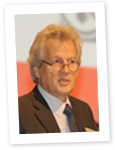Frank de Wolf reviews 11 years at SHM
 After 11 years as director of Stichting HIV Monitoring (SHM), Frank de Wolf has decided to say goodbye to the foundation. He will continue his career at biopharmaceutical company Crucell as Medical Director and General Manager of the Crucell Vaccine Initiative. He will continue working at SHM until December 1, 2012. In this article he looks back at his time with the foundation.
After 11 years as director of Stichting HIV Monitoring (SHM), Frank de Wolf has decided to say goodbye to the foundation. He will continue his career at biopharmaceutical company Crucell as Medical Director and General Manager of the Crucell Vaccine Initiative. He will continue working at SHM until December 1, 2012. In this article he looks back at his time with the foundation.
The SHM was established in 2001, resulting from the successful "AIDS Therapy Evaluation in the Netherlands" (ATHENA) project. Frank Wolf was a senior researcher and coordinator involved in ATHENA and one of the initiators of the establishment of SHM. Since 2002, the SHM has been recognized by the Ministry of Health as the organization together with HIV treatment centres that monitors and contributes to the promotion of quality HIV care in the Netherlands.
How do you look back on the time you’ve spent as director of SHM?
I’m very content and proud of what has been achieved to date. SHM was founded in 2001 and the activities of monitoring, collecting data from HIV-infected patients in care, started in February 2002. The foundation took over the database from ATHENA which was then expanded to include more data items per patient, and has continued to expand ever since. Over an 11 year period, we have grown to an organisation of over 40 people. We have developed routine procedures that streamline the data collecting and monitoring process. I would go as far as to say that we have the best HIV data collection of any country in Europe, and perhaps in the world.
We have a comprehensive overview of treatment and the issues related to treatment, and we know a great deal about the epidemic in the Netherlands. We have developed a system that can be used by doctors for patient care and we can also use the data for policy issues related to HIV care. We are also in a position to contribute to European collaborations focused on a variety of HIV-related matters including treatment, comorbidities and the development of resistance. This machinery produces a large number of scientific publications which contributes significantly to the knowledge on HIV and AIDS. I’m very happy to have been involved in this whole process and have found my work at the foundation to be very rewarding.
What do you think are the greatest successes of SHM?
I think one of our greatest successes is in building an organisation that is acknowledged and used by doctors throughout the Netherlands in treating HIV-infected patients. We are pretty unique in the field of infectious diseases in that we’re no only collecting data but give results back overnight, and that’s a big achievement.
What do you think is SHM’s most important contribution to HIV care?
I think this would be in terms of knowledge. We have made important contributions to the knowledge of comorbidities in HIV and on the effect of treatment of HIV in regular settings, and what can be achieved. When treatment of an infection like HIV takes place on a massive scale then you have an impact on the epidemic, changing the course of the epidemic over time. It can slow down the epidemic, but at the same time it can change the virus. An example is that because of effective treatment, the window of opportunity for transmitting the virus is shorter and as a result the virus becomes more virulent. This shows as an increasing viral load, or amount of virus circulating in the body, over time at viral set-point.
Would you do anything different if you look back at your time at the foundation?
In hindsight, when SHM started I may have been too strict in sharing data with doctors, but on the other hand, in building up an organisation you don’t always have the opportunity to be generous. Also, perhaps the contact with microbiology and immunology laboratories was a bit too limited. I think it we’d had better contact we would have a better overview of outcomes related to HIV care. These relationships are improving now but it’s something for my successor to work on further.
What do you consider important focal points for your successor?
I would suggest that the new director focuses on broadening the scope of SHM to cover other infectious or non-infectious diseases. To do this, SHM will need to broaden the collaborations with hospitals throughout the Netherlands.
There also needs to be further development of the bridging work between treatment and prevention and collaborative efforts are needed there. This type of work is important when considering topics like PrEP (pre-exposure prophylaxis).
Finally, I’d like to say that although a lot has been achieved since 2001, I believe that there are still many opportunities in the monitoring of HIV. These include opportunities in developing SHM further as a leading organisation in providing information and knowledge on the treatment and care of HIV-infected patients, as well as on the HIV epidemic in the Netherlands. I trust that over the coming years SHM will continue to work in the same tireless fashion, and go from strength to strength.
